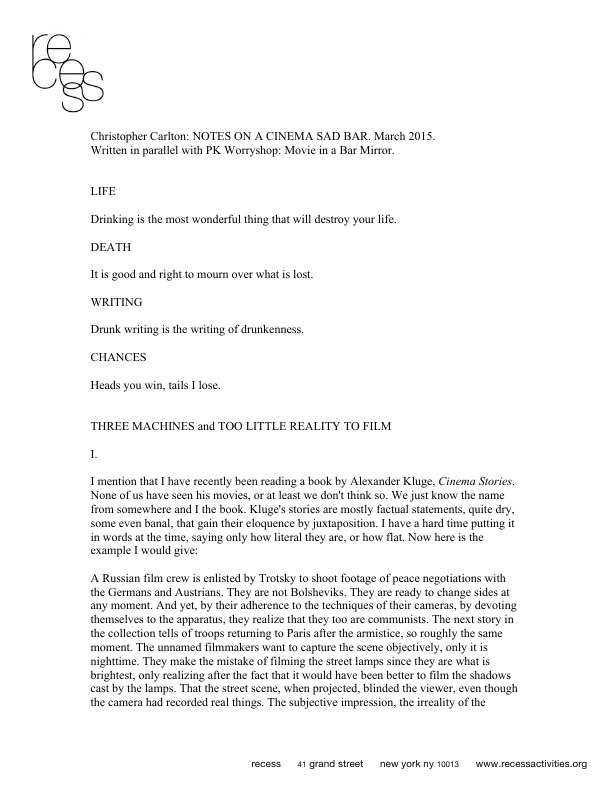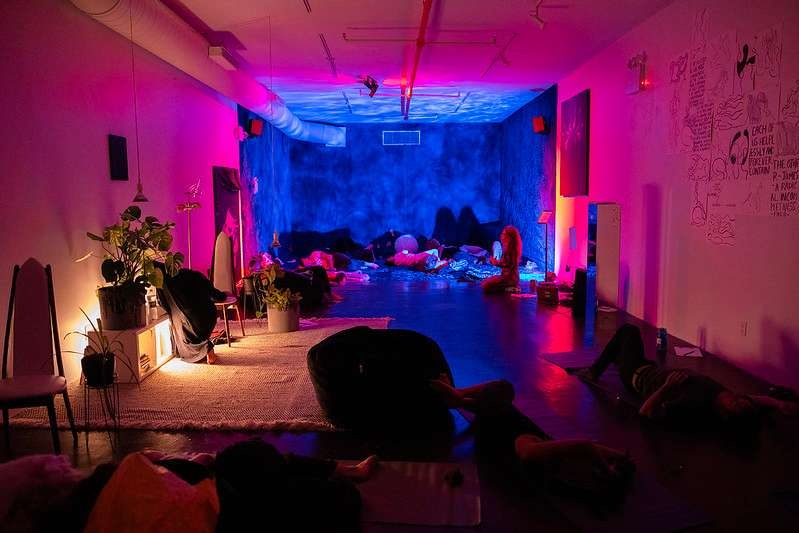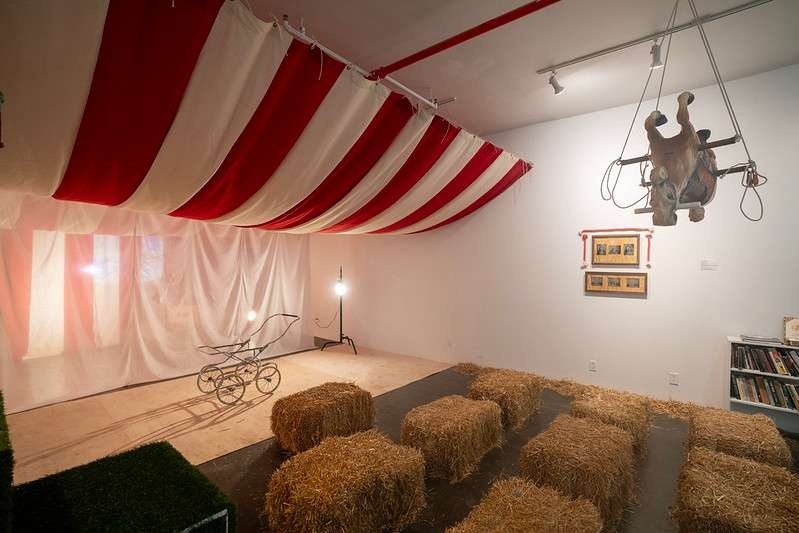NOTES ON A CINEMA SAD BAR
LIFE
Drinking is the most wonderful thing that will destroy your life.
DEATH
It is good and right to mourn over what is lost.
WRITING
Drunk writing is the writing of drunkenness.
CHANCES
Heads you win, tails I lose.
THREE MACHINES and TOO LITTLE REALITY TO FILM
I.
I mention that I have recently been reading a book by Alexander Kluge, Cinema Stories. None of us have seen his movies, or at least we don’t think so. We just know the name from somewhere and I the book. Kluge’s stories are mostly factual statements, quite dry, some even banal, that gain their eloquence by juxtaposition. I have a hard time putting it in words at the time, saying only how literal they are, or how flat. Now here is the example I would give:
A Russian film crew is enlisted by Trotsky to shoot footage of peace negotiations with the Germans and Austrians. They are not Bolsheviks. They are ready to change sides at any moment. And yet, by their adherence to the techniques of their cameras, by devoting themselves to the apparatus, they realize that they too are communists. The next story in the collection tells of troops returning to Paris after the armistice, so roughly the same moment. The unnamed filmmakers want to capture the scene objectively, only it is nighttime. They make the mistake of filming the street lamps since they are what is brightest, only realizing after the fact that it would have been better to film the shadows cast by the lamps. That the street scene, when projected, blinded the viewer, even though the camera had recorded real things. The subjective impression, the irreality of the soldiers’ shadows against the sidewalks and buildings, would have been preferable. So many would never return.
PKworryshop recognize this flat storytelling, its reportage quality, from another New German Cinema director. They describe how Wim Wenders wanted to produce moving images that did not refer to some meaning exterior to the frame. Somewhere, Wenders describes an argument, either with a filmmaker of the older generation or a member of his own crew, over a shot inside the cab of a truck. The truck goes through a long tunnel, and the film camera records but captures little to no light. For the edit, Wenders does not cut to the other end of the tunnel. He leaves in this rumbling darkness. He is asked why and says “But so much happens in the tunnel!”
What I can tell them at the time, and do, is that Kluge writes that cinema was made up of three machines. The first machine, the movie camera, is a combination of the still camera, the sewing machine, and the bicycle. The second machine does not need to be invented, only repurposed: the theater with its box office, seats, stage. Lastly, there is the machine that produced an audience for moving images: the penny arcade: “A peep cost one cent. The automatic machines stood side-by-side along the thoroughfares as people returned home from work.” Before there could be a mass audience in a movie theater there had to be a solitary spectator. The penny arcade quickly turned into the cinema shop. The cinema shop took over the theater. Movies got their start in the anonymity of the city street. A mass audience is ultimately an anonymous audience, not a collective one. Mass industrial projects and elaborate bureaucracies required atomization of the individual worker, and the penny arcade provided a solitary, fleeting diversion. We have come full circle with the cellphone, adding the mobility of the surface and the proliferation of its content while abandoning the shared viewership of the theater. The Scopitone is one of the faltering steps on this circular way: anticipating the music video, but also updating the penny arcade’s peep show, to arrive where we are hunched over our hands. Like television, the Scopitone comes along after World War II, and, like television, it shares in the collapse of a cinema public.
II.
The other night I watched the television late at night at a bar. The sound was off. The television show seemed to be about long distance trucks that had fallen over. When a truck falls over, other trucks with cranes come along to put the trucks that have fallen over upright again. Elsewhere, Kluge observes that the cinema only began producing fictional material when there was not enough reality to film, not enough historical events and spectacles to capture. It is unclear whether this “not enough reality to film” was merely a technical problem, the difficulty of getting the machinery in place must have required knowing well in advance about a given event, or if it means something deeper about a resistance in reality itself against being footage, a resistance that has now fallen away.
BAR FLY
I swore I had been in that bar. The one with the leather edge to the bar top. Or perhaps I had seen it in another movie. Stages can be reused quite easily, but so can reality.
CASABLANCA
Where to in Morocco during World War II could they drive all night? Where could they go fishing? What Sam is saying is that in the movie the whole world is America. In the whole world, there is nowhere for him to escape America.
CRYIN’ TIME
The neon light at the top of the frosted, storefront windows, facing out onto the street, flashes on and off in blind repetition: “Cryin’ Time”. We are just at the edge of the neighborhood, before it is swallowed up in the overwhelming logistical apparatus of Holland Tunnel. From across the street all the way through the entrance, you are in the scene Cryin’ Time. Entering through the storefront, you step up on the hollow bandstand before stepping down to the gallery’s hard floor. There is no other way in. These steps are quickly forgotten, yet not without remainder, some inner change. This scene takes place throughout the residency. The Sad Bar is not simply an installation. It exists as a set. Movies happen in it, both real productions and potential ones. Artists’ studio and movie studio are one, and what happens in this residency is now cinema space. Cinema space produces a reality that cannot exist outside of the frame. Everything in the frame is real and yet only exists for its specific duration. A character has no past or future, even when these are hinted at in the script. When a character walks into a bar, they walk into that bar for the rest of eternity. When “Cryin’ Time” hangs in neon lights above the door, the sign glows on and off forever. The space is like a bar, but it is neither an imitation of one, nor simply a gallery anymore either. Movies and bars have no exterior. They are where you go when you refuse that nothing can happen. Drinking is cinema. The drink suspends nothingness by way of nothingness. You disappear into space. Time stops. Or, since eventually you have to go home, or you get hungover, all that, time slows down. Take the edge off, quiet the mind, ease the body twisted up. You are a point in space, looking out, and there it is, everything, outside of you, but you feel it, everything, in a great imaginary communion, a big old sob. Don’t touch my fucking drink!
THE EVENT
There is a moment where the blur of the nighttime video footage catches you up and you think: perhaps video really can be what we would have hoped for it to be. One realizes, and without having been able to anticipate the result, that the Cryin’ Time releases everyone briefly from what holds them. The video stream of the sad bar crawl, while it interrupted, buffered, and looped, produced a waiting, a walking in the cold, a texting, a pissing, the anxiety of being out, all transferred to the solitary figure we cannot see, who trudges along out there for us. The video wants to disappear and stay with you forever. Absolved by this lonely figure, we are, moving from conversation to conversation – the lights projected onto the scene of the bar, and the band, half-ignored, playing its sad songs beneath Morandi bottles. The moment Blue Moon begins to play, when the singer plaintively destroys the song, you realize you are in the movie. It has happened. The scene in Cryin’ Time was performed and projected but will never be captured.
Later, PKworryshop explain that the man walking in the cold is lost. He knows he is trying to arrive somewhere but cannot know where. The room with the projector in it, that shows a video ahead of his footsteps, is the destination he attempts to, but will not, find. We are there waiting, but just as he is helpless so are we. We cannot tell him how to find us. He cannot hear us. The streets he walks down are not familiar to us. The bars are not our own, although we are sure that, at any moment, if we focus hard enough, the blurry video will come into focus, and we will see.
THREE VIDEOS
PKworryshop tell me about three videos for the closing, and we watch snippets of the footage. In the first, in the first, written and directed by Clemens Poole after a series of back and forth conversations with PKworryshop about the sad bar, a man is sitting by the side of a cold Finnish highway putting on an extra pair of socks. He has taken them out of a plastic shopping bag. He also puts on some new winter mittens. Two other men show up where he is on the edge of this abandoned, roaring highway. They stand over the first man in his fresh socks and mittens. The two standing men both have scarves wrapped around their faces. What might happen? These are intimidating looking fellows standing over the first man. Are they friends or enemies? One of the newcomers slowly unrolls his scarf to reveal face and neck. He takes two of his fingers and flicks them against his neck, about at the aorta. Some kind of signal. After flicking his neck, he holds up three fingers. The first man seems to know what this means. He nods yes, and the three walk back along the highway in the direction from which the two had come. Now in a parking lot, one man is returning to the other two with a bottle of vodka. They stand in a circle, and, one after the other, they mark out a third of the bottle with their finger and drink their proper third. They do this in quick succession, then go their separate ways. PKworryshop say that flicking the throat like this is a signal to drink. The story of why this is the case was quite mysterious. Apparently, there was a man who won a contest, and the prize was a token that gave him free drinks in any bar in the land. By what agreement, I don’t know. That very night he drinks so much that he loses the token. So the next day he goes back to the people who gave it him. This time they give him a tattoo on his neck so that he won’t lose it again. The day was so cold. After walking back and forth, this way and that, the boredom and crushing ugliness of the highway, the vodka felt warm in my stomach. My mood gently dissipated in the mood of the cold evening.
In the second, written and performed by Lex Rocket, a man recreates the final scene of Claire Denis’ Beau Travail, one of the most final scenes in the history of cinema, wherein a French foreign legion soldier, disgraced and forced to return to France, dances to “The Rhythm of the Night” alone in a disco. He is dancing in front of the mirrors that, since the first event, PKworryshop has set up to split the sad bar in half. He is dancing right there where I am now sitting watching the footage on a laptop. They recorded him dancing for a long time, many hours. He is exhausted from dancing. The surface of the mirror will never turn away, and as long as it faces him he must dance.
In the third, derived from a longer screenplay written by Olivia Ahn with cinematography and editing by Masami Kubo, a woman walks into the set, the studio, the project space, en bref, the sad bar. At the bar are all her former lovers, in a row, and she will proceed to share a drink, and a kiss that releases all of the liquid back from the mouth, with each. The first shot is low to the ground. The camera pulls a pair of high heeled feet step by step into the room like a summons. As the legs step forward the camera recedes across the floor. Inserts, like tracking shots, settle in at the cinema sad bar to stay forever. When someone orders a drink by putting their finger up as a signal to the bartender, you see a shot of the finger floating in the frame. The finger floats there in space for the rest of eternity.
MIRROR
I am looking into the mirror. I have aged.
About the artist
Christopher Carlton
Projects
Explore/Archive
See allDecember 2025
The INSTITUTE FOR TRANSHUMANIST CEPHALOPOD EVOLUTION and Learning from Octopuses
Barbara London
Barbara London reflect's of Miriam SImun's INSTITUTE FOR TRANSHUMANIST CEPHALOPOD EVOLUTION
October 2025
streamlined reflections, courtesy of noise canceling headphones
Gabrielle Rucker
Gabrielle Rucker reflects on the radical intimacy and auditory life at the heart of Deli Radio
July 2025
Tell My Jockey: CUNTRY’s Discourse From the Horse’s Mouth
Ericka Pérez
Assembly fellow Ericka Pérez reflects on clowning, resistance, and CUNTRY’s radical refusal to perform.







